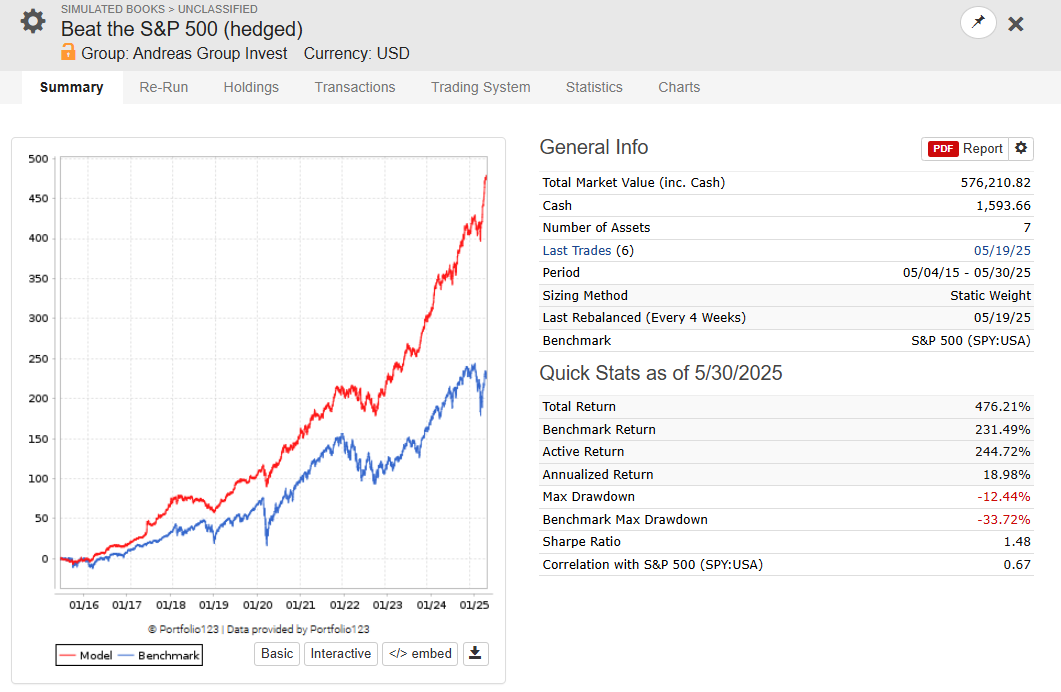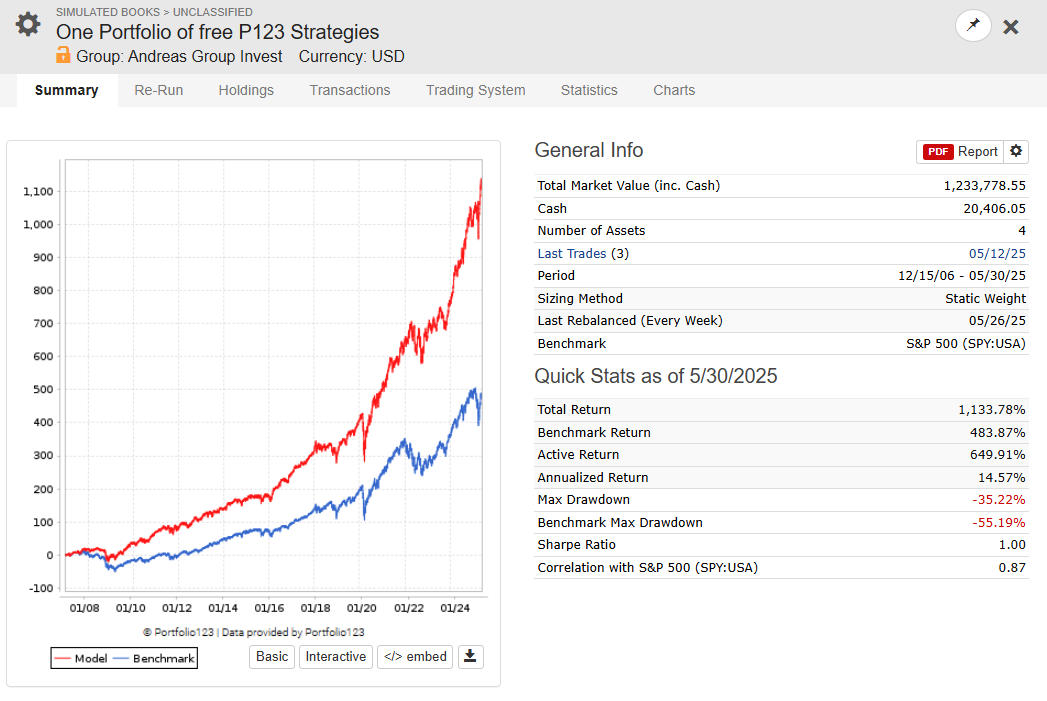Consider becoming a paying subscriber of this Substack. All posts are free, but I need some paying subscribers, otherwise Substack is going to kick me out ;-)
Wait until the live strategy books from this post have rebalanced, I need to send out now due to time contraints!
Link to Research Group in P123
https://www.portfolio123.com/app/group/317
Links to Simulated Strategy Books
https://www.portfolio123.com/app/opener/BOOKSIM/?cat=G317
Links to corresponding Live Strategy Books:
https://www.portfolio123.com/app/opener/BOOK/?cat=G317
Here are the cap curves of the Strategy Books (cap curve updated today).
Beat the S&P 500 Young Investors: Out of sample live trading about October 2024
The following Strategy Books is not hedged, therefore for “younger” investors that still cost average into a strategy book.
https://www.portfolio123.com/port_summary.jsp?portid=1854360
Corresponding Live Book:
https://www.portfolio123.com/port_summary.jsp?portid=1854588
Beat the S&P 500 (hedged) OOS about October 2024
https://www.portfolio123.com/port_summary.jsp?portid=1814216
Corresponding Live Book
https://www.portfolio123.com/port_summary.jsp?portid=1854426
One Portfolio of Free P123 Strategies
https://www.portfolio123.com/port_summary.jsp?portid=1853788
Corresponding Live Book
https://www.portfolio123.com/port_summary.jsp?portid=1854427
One Portfolio of Free P123 Strategies - Hedged
Corresponding Live Book
https://www.portfolio123.com/port_summary.jsp?portid=1854584
Video on how to use the Live Strategy Books and auto trade via Tradier and Interactive Brokers Pro.
Strategy Books are now shareable in Research Groups of Portfolio123.com
We are just starting out, but I will share a ton of Strategy Books in the coming weeks: Perfect for private Investors that want to use time proven out of sample Strategies in one holistic Strategy Book!
Macro Assumptions in Strategy Books:
Gold is not only a very good diversifier, but will have a positive expectancy the next 5 -10 years: too much money printing of CBs, we live in a mild “Financial Repression” (e.g. Inflation is going to run you over drop by drop, if you are not invested in hard assets like Gold, Quality Stocks, Quality Real Estate)
Russel 2000 is the worst index in the US and therefore a good short (as a hedge!), a lot of companies in the index that cannot even earn their interests on their debt. Do not short EU small caps, a lot of good fundamentals there!
The Strategy books harvest “Cross Factor Mean Reversion”, e.g. the idea is that we balance quality, low volatility and growth in the strategy books. When growth is weak, quality and low volatility and the gold exposure “kick in”. When growth is strong, quality and low volatility and gold lag, but do not kill the performance of the strategy book.
Best Regards
Andreas
P.S. Explanation of Cross Factor Mean Reversion
Cross Factor Mean Reversion
Why is cross-factor mean reversion so powerful?
First, mean reversion has persistence. When a factor gets extremely out of favor, it often rebounds with force. This is especially true for classic factors like value or low volatility. They can go from being the "worst idea ever" to "everyone’s favorite allocation" in just a few months.
Second, it capitalizes on behavioral overreaction. Markets tend to over-discount factors. If investors flee value stocks en masse, the price distortions become extreme. Eventually, rebalancing flows and fundamental corrections bring those factors back into favor.
Third, factors are usually uncorrelated at turning points. When growth cracks, value might shine. When high beta stumbles, low volatility leads. That low correlation between factors—especially during reversals—makes timing even more lucrative, if done right.
Factor timing is incredibly noisy. Trying to predict which factor will outperform next is one of the hardest problems in quantitative investing. Macro signals, interest rates, and valuation spreads help, but they’re imprecise and often lag. It’s easy to chase strength too late or exit weakness just before it rebounds.
False starts and whipsaws are common. You might see value outperform for a few weeks, only to give it all back. Factor rotations aren’t smooth—they’re violent and often disrupted by market shocks like Fed actions or geopolitical events.
Cross-factor regimes also don’t always follow macro logic. Sometimes low volatility leads in bull markets. Sometimes momentum fails during panics. These reversals behave more like investor crowd psychology than economic textbook patterns.
Timing also requires Goldilocks speed - neither too fast nor too slow. If you’re too slow, you miss the bounce. If you’re too fast, you churn capital reacting to noise. Cross-factor moves often happen in bursts, so even a few days later can cost the edge.
Why combining strategies with clear factor tilts with regular rebalance wins
Because timing is so difficult, many smart strategies simply hold a balanced exposure to multiple meta-factors, let mean reversion work in the background, and regular rebalance.
For example, building a book of single-factor strategies—like one value, one momentum, one quality—and letting them rotate inside the book is a form of implicit timing without having to make explicit calls.
The takeaway
Cross-factor mean reversion is one of the most durable and powerful forces in quant investing. It captures the natural ebb and flow of entire factor styles rotating in and out of favor. But trying to time those shifts is incredibly hard due to noise, false starts, and behavioral volatility. The better approach is often diversified exposure across factors and allowing the reversion to work for you—not against you.
Cross-factor mean reversion + 25% gold = hidden alpha combo?
If you’ve built a diversified book of multi-factor equity strategies—especially ones that benefit from cross-factor mean reversion—you might already have something robust. But adding a 20% gold position can take it to another level.
Why gold adds so much value
First, gold is non-correlated to equities. It doesn’t care about earnings revisions, factor momentum, or what the Fed says about buybacks. It often moves in a different direction than equity factors - making it an ideal diversifier.
Second, it acts as a tail risk hedge. In moments of market stress, inflation shocks, or geopolitical risk, gold can spike while equities suffer. That buffers drawdowns and creates dry powder for rebalancing.
Third, it improves Sharpe ratio and reduces volatility. In both backtests and real usage, a 20% gold allocation has often produced smoother equity curves, lower portfolio volatility, and better risk-adjusted returns.
Fourth, it’s a great fit for cross-factor regime shifts. When one equity factor crashes and another hasn’t picked up yet, gold provides a bridge—helping your portfolio hold ground until the next leader emerges.
Gold and cross-factor timing
Think of gold as the shock absorber in your equity factor engine. It’s the rotational glue that helps you survive messy handoffs between winners and losers. It’s the anchor when nothing else in equities works.
Try this portfolio idea: 80% multi-factor equity book with cross-factor exposure and/or AI factor models, and 20% gold or gold proxy like GLD or physical gold. You’re not betting on gold - you’re buying resilience.















